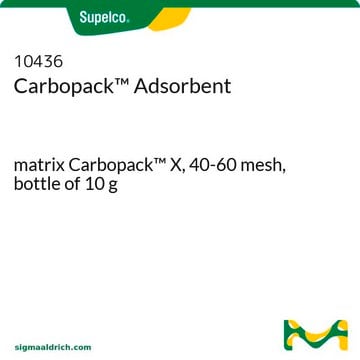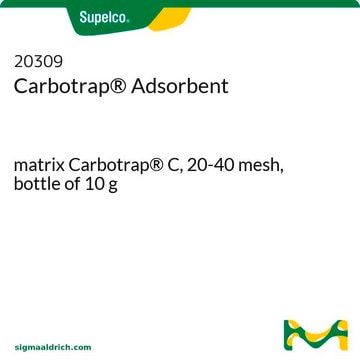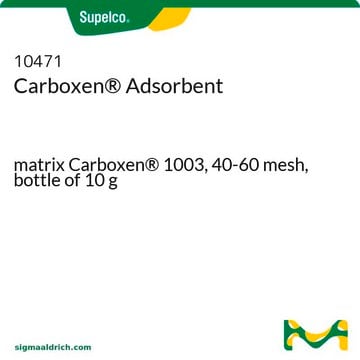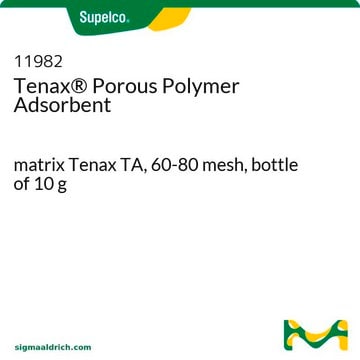10435-U
Carbotrap® Carbon Adsorbent
matrix Carbotrap® X, 20-40 mesh, bottle of 10 g
About This Item
Produtos recomendados
product name
Carbotrap® Adsorbent, matrix Carbotrap® X, 20-40 mesh, bottle of 10 g
linha de produto
Carbotrap®
forma
granular
embalagem
bottle of 10 g
técnica(s)
LPLC: suitable
área da superfície
~240 m2/g
matriz
Carbotrap® X
Grupo ativo da matriz
carbon
tamanho de partícula
20-40 mesh
tamanho de poro
~0.62 cm3/g mesoporosity
~0 cm3/g macroporosity
~0 cm3/g microporosity
~100 Å pore diameter
densidade
~0.44 g/mL (free fall density)
técnica de separação
reversed phase
Procurando produtos similares? Visita Guia de comparação de produtos
Descrição geral
- Granular
- Friable
- Used for molecules with an analyte size relative to C3-C20+ n-alkanes
- Hydrophobic (can be used in high humidity environments)
Generally, GCB adsorbents offer weaker relative adsorptive strength compared to carbon molecular sieve (CMS) adsorbents, and similar relative adsorptive strength compared to spherical graphitized polymer carbon (SGPC) adsorbents. Our Carbotrap products are a type of GCB adsorbent.
- Particles are 20/40 mesh
- These large particles allow high flow rates without excessive pressure drops
For more information about any of our specialty carbon adsorbents, please visit sigma-aldrich.com/carbon
Informações legais
Código de classe de armazenamento
11 - Combustible Solids
Classe de risco de água (WGK)
nwg
Ponto de fulgor (°F)
Not applicable
Ponto de fulgor (°C)
Not applicable
Equipamento de proteção individual
Eyeshields, Gloves, type P3 (EN 143) respirator cartridges
Choose from one of the most recent versions:
Certificados de análise (COA)
Sorry, we don't have COAs for this product available online at this time.
If you need assistance, please contact Atendimento ao cliente
Já possui este produto?
Encontre a documentação dos produtos que você adquiriu recentemente na biblioteca de documentos.
Os clientes também visualizaram
Artigos
Synthetic CMS carbons offer tailored adsorbents for specific applications.
Nossa equipe de cientistas tem experiência em todas as áreas de pesquisa, incluindo Life Sciences, ciência de materiais, síntese química, cromatografia, química analítica e muitas outras.
Entre em contato com a assistência técnica





